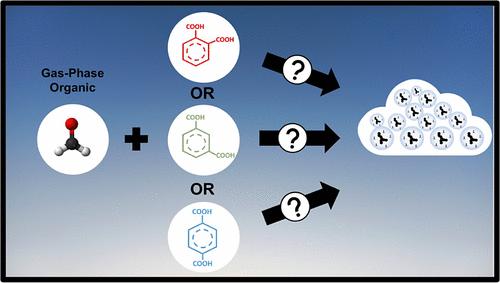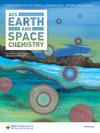有机蒸汽在有机气溶胶吸水过程中的作用
IF 2.9
3区 化学
Q2 CHEMISTRY, MULTIDISCIPLINARY
引用次数: 0
摘要
有机溶剂在大气中无处不在,很容易在颗粒周围形成一个涂覆层。虽然有机溶剂的存在已被广泛报道,但人们对其对云滴形成的影响却知之甚少。本研究阐明了一种主要有机溶剂在相关环境条件下对有机气溶胶吸水的影响。具体来说,我们研究了三种不同溶解度的有机异构体(即邻苯二甲酸(PTA;高溶解度)、间苯二甲酸(IPTA;部分溶解度)和对苯二甲酸(TPTA;低溶解度))在水相和气相乙醇(EtOH)存在下产生的气溶胶的吸水率。利用实验室测量方法,分别使用云凝结核计数器(CCNC)和吸湿串联微分迁移率分析仪(H-TDMA)研究了过饱和和半饱和条件下的吸水特性。在过饱和条件(0.86%)下,报告了每个体系的临界直径(Dd),并与纯化合物进行了比较。在过饱和环境下,EtOH 的存在提高了部分和低溶解度颗粒、IPTA 和 TPTA 的吸水率,但没有提高水溶性 PTA 颗粒的吸水率。在过饱和环境中,气溶胶粒子的固有溶解度决定了其吸水行为。由于 PTA 具有高水溶性,EtOH 的存在对 PTA 颗粒的溶解几乎没有影响。因此,EtOH 对 PTA 颗粒的吸水率没有影响。与纯 PTA 颗粒相比,含有 EtOH 的 PTA 系统的临界直径变化极小(0.1-2 nm),这就说明了这一点。相反,在 IPTA 和 TPTA 气溶胶中添加乙醇可提高这些部分/低水溶性颗粒的溶解度,从而增加其吸水亲和力。在 IPTA 和 TPTA 颗粒中加入乙醇后,临界直径分别减小了 ∼6-8.2 和 ∼16-20.1 nm。亚饱和结果表明,与过饱和结果相比,乙醇具有相反的效果。在亚饱和环境下,PTA 颗粒的吸水亲和力因 EtOH 的存在而增强,而 IPTA 和 TPTA 颗粒的吸水亲和力则减弱。乙醇水溶液的存在增强了 PTA 的吸水性(Gf 从 1.02 升至 1.23),而 IPTA 和 TPTA 颗粒的尺寸则减小了(Gf 从 1.01 降至 0.95)。这归因于 TEM 图像和形状系数测量所支持的颗粒形态特性。因此,大气中的有机溶剂很容易包裹气溶胶粒子,并在亚饱和和超饱和条件下对吸水特性起着重要作用。本文章由计算机程序翻译,如有差异,请以英文原文为准。

The Role of Organic Vapor in the Water Uptake of Organic Aerosols
Organic solvents are ubiquitous in the atmosphere and can readily form a coated layer around the particles. While their presence has been widely reported, their effects on cloud droplet formation have been poorly understood. This study elucidated the effect of a prominent organic solvent on the water uptake of organic aerosols under the relevant environmental conditions. Specifically, we investigated the water uptake efficiencies of aerosols obtained from three organic isomers of different solubilities, namely, phthalic acid (PTA; high solubility), isophthalic acid (IPTA; partial solubility), and terephthalic acid (TPTA; low solubility) in the presence of aqueous-phase and gas-phase ethanol (EtOH). Using laboratory-based measurements, the water uptake properties were investigated under supersaturated and subsaturated conditions by using a cloud condensation nuclei counter (CCNC) and a hygroscopicity tandem differential mobility analyzer (H-TDMA), respectively. Under supersaturated conditions (0.86%), the critical diameter (Dd) of each system was reported and compared relative to the pure compounds. Under a supersaturated environment, the presence of EtOH was shown to increase the water uptake efficiency of partial and low solubility particles, IPTA and TPTA, but not the water-soluble PTA particles. In supersaturated environments, the intrinsic solubility of aerosol particles governs its water uptake behavior. Since PTA exhibits a high-water solubility, the presence of EtOH exerted little to no influence on the dissolution of PTA particles. Hence, EtOH had no impact on the water uptake of PTA particles. This is signified by the minimal change in critical diameter (∼0.1–2 nm) between the PTA systems that contained EtOH compared with the pure PTA particles. Conversely, the addition of EtOH to IPTA and TPTA aerosols enhanced the dissolution of these partial/low-water solubility particles, as a result, increasing their water uptake affinity. The addition of ethanol to IPTA and TPTA particles resulted in a decrease in critical diameter by ∼6–8.2 and ∼16–20.1 nm, respectively. Our subsaturated results show that EtOH has the opposite effect relative to our supersaturated results. Under a subsaturated environment, the water uptake affinity of PTA particles was enhanced by the presence of EtOH and diminished for IPTA and TPTA particles. The water uptake of PTA was enhanced with the presence of aqueous ethanol (Gf increased from ∼1.02 to ∼1.23), while IPTA and TPTA particles showed reduction in size (Gf decreased from ∼1.01 to ∼0.95). This is attributed to the morphological properties of the particles supported by TEM images and shape factor measurements. Hence, atmospheric organic solvents can readily coat aerosol particles and play a major role in the water uptake properties under sub- and super-saturated conditions.
求助全文
通过发布文献求助,成功后即可免费获取论文全文。
去求助
来源期刊

ACS Earth and Space Chemistry
Earth and Planetary Sciences-Geochemistry and Petrology
CiteScore
5.30
自引率
11.80%
发文量
249
期刊介绍:
The scope of ACS Earth and Space Chemistry includes the application of analytical, experimental and theoretical chemistry to investigate research questions relevant to the Earth and Space. The journal encompasses the highly interdisciplinary nature of research in this area, while emphasizing chemistry and chemical research tools as the unifying theme. The journal publishes broadly in the domains of high- and low-temperature geochemistry, atmospheric chemistry, marine chemistry, planetary chemistry, astrochemistry, and analytical geochemistry. ACS Earth and Space Chemistry publishes Articles, Letters, Reviews, and Features to provide flexible formats to readily communicate all aspects of research in these fields.
 求助内容:
求助内容: 应助结果提醒方式:
应助结果提醒方式:


